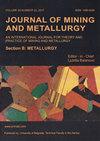微波加热高效萃取钒渣中的V、Cr、Ti、Fe和Mn
IF 0.9
4区 材料科学
Q3 METALLURGY & METALLURGICAL ENGINEERING
Journal of Mining and Metallurgy Section B-Metallurgy
Pub Date : 2021-01-01
DOI:10.2298/JMMB190827023T
引用次数: 0
摘要
钒渣(V渣)是钒钛磁铁矿冶炼产生的,其中含有V、Ti、Cr、Fe、Mn等有价元素。传统的方法主要是通过氧化或还原法提取钒和铬。在本工作中,采用氯化法使各元素的价态保持原态。为了加速元素的扩散和降低熔盐的挥发性,本文对微波加热进行了研究。结果表明,在800℃下对V渣进行氯化处理仅需30 min, V、Cr、Mn、Fe和Ti的氯化率分别可达82.67%、75.82%、92.96%、91.66%和63.14%。与常规加热8 h的结果相比,微波加热的提取率具有更大的优势。此外,微波加热可以通过缩短反应时间有效地减少AlCl3的挥发。微波加热时AlCl3的挥发率为3.92%,而传统加热(1h)时为8.97%。高效氯化反应的机理可以归结为局部高温对离子扩散过程的增强和化学反应的增强。本文章由计算机程序翻译,如有差异,请以英文原文为准。
High efficiency extractions of V, Cr, Ti, Fe and Mn from vanadium slag by microwave heating
The vanadium slag (V-slag) is generated from smelting vanadium titanomagnetite ore, which contains valuable elements, such as V, Ti, Cr, Fe and Mn. The traditional methods were mainly focused on the extractions of V and Cr by oxidation or reduction processes. In the present work, chlorination method was adopted to keep the valence state of each elements as original state. In order to speed up the diffusion of elements and reduce volatility of molten salt, microwave heating has been examined in the current paper. The results indicated that it only took 30 min to chlorinate V-slag at 800 ?C, and the chlorination ratios of V, Cr, Mn, Fe and Ti could reach to 82.67%, 75.82%, 92.96%, 91.66% and 63.14%, respectively. Compared with the results by conventional heating for 8 h, this extraction rate by microwave heating shows greater advantages. In addition, microwave heating can reduce effectively volatilization of AlCl3 by shortening the reaction time. The volatilization ratio of AlCl3 in this microwave heating was 3.92% instead of 8.97% in conventional heating (1h). The mechanism of efficient chlorination can be summarized as the enhancement of ions diffusion process and enhanced chemical reaction due to local high temperature.
求助全文
通过发布文献求助,成功后即可免费获取论文全文。
去求助
来源期刊
CiteScore
2.00
自引率
40.00%
发文量
19
审稿时长
2 months
期刊介绍:
University of Belgrade, Technical Faculty in Bor, has been publishing the journal called Journal of Mining and Metallurgy since 1965 and in 1997 it was divided in two independent journals dealing with mining and metallurgy separately. Since 2009 Journal of Mining and Metallurgy, Section B: Metallurgy has been accepted in Science Citation Index Expanded.
Journal of Mining and Metallurgy, Section B: Metallurgy presents an international medium for the publication of contributions on original research which reflect the new progresses in theory and practice of metallurgy. The Journal covers the latest research in all aspects of metallurgy including hydrometallurgy, pyrometallurgy, electrometallurgy, transport phenomena, process control, solidification, mechanical working, solid state reactions, materials processing, surface treatment and relationships among processing, structure, and properties of materials.

 求助内容:
求助内容: 应助结果提醒方式:
应助结果提醒方式:


